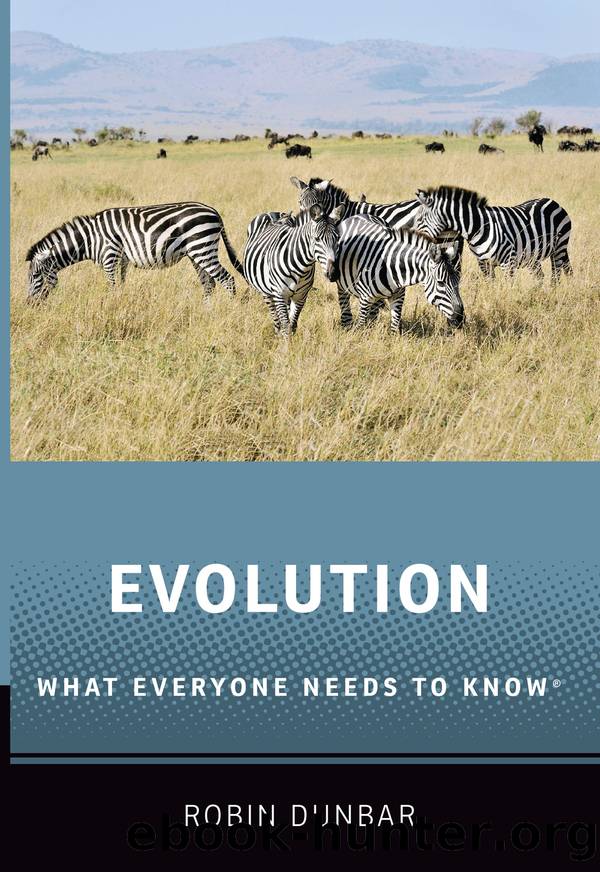Evolution by Robin Dunbar

Author:Robin Dunbar
Language: eng
Format: epub
Publisher: Oxford University Press
Published: 2015-11-15T00:00:00+00:00
54. Do ecosystems evolve?
Given that species evolve, and even that groups of species can coevolve (for example as predators and prey) (see Questions 52 and 53), it is perhaps natural to ask whether ecosystems that consist of many species bound together in a complex web of interrelationships also evolve. If evolution just means change over time, then of course they do, and that probably isnât terribly interesting. What is more interesting is whether there are regularities in their evolutionary trajectories. After all, the universe itself has evolved, and in a very prescriptive way driven by the fundamental laws of physics. But does this also apply to environments and their constituent animal and plant communities?
At one level, the answer is definitely yes (see Question 53). But there are other regularities in the way ecosystems as a whole evolve. If forests are destroyed by volcanic eruptions, hurricanes, wildfires, or even glaciations, recolonization follows a very regular pattern that may in fact reflect the evolutionary history of plant life and terrestrial habitats. Initially, in a phase known as primary succession, algae, lichens, and fungi colonize the area and help to build up the soil (they are particularly important if the destruction has removed most of the soil, as glaciations often do). These are referred to as pioneer species because they appear first. As soil quality improves, species like grasses and ragweeds that can cope with poor soils appear. These help to stabilize the soil by preventing wind erosion; they also help to hold water in the soil, a crucial step for the next phase. This phase is dominated by species with small seeds or spores that can remain dormant for long periods if the habitat dries out but which can also easily disperse, especially on the wind. These species are often ones that can fix nitrogen in the soil by extracting it from the air. This is crucial for the next phase as nitrogen is often a limiting resource for plants, most of which acquire their nitrogen from the ground. As they die and decay, they build up soil depth and richness.
The second phase (secondary succession) involves the arrival of more conventional shrubs and then trees, often in a well-defined sequence. Annual plants are often the first to appear, as they can cope better with poor, uncertain conditions. After these have established themselves, shrubs and small trees like pines, oaks, and hickory (known as âcolonizer speciesâ) become established. Once these get established, they are gradually replaced by more substantial forest trees that introduce more canopy layers. These tree species often fight for sunlight rather than soil, which is why they typically grow very tall and why there is often very little ground-level vegetation beneath them. After about 150 years, the forest will have a species composition that will remain stable, often for many thousands of years. These are known as âclimax habitats.â Of course, the composition of species may not be exactly the same as the original forest, since it will depend on
Download
This site does not store any files on its server. We only index and link to content provided by other sites. Please contact the content providers to delete copyright contents if any and email us, we'll remove relevant links or contents immediately.
| Africa | Americas |
| Arctic & Antarctica | Asia |
| Australia & Oceania | Europe |
| Middle East | Russia |
| United States | World |
| Ancient Civilizations | Military |
| Historical Study & Educational Resources |
The Bomber Mafia by Malcolm Gladwell(1183)
Submerged Prehistory by Benjamin Jonathan; & Clive Bonsall & Catriona Pickard & Anders Fischer(1162)
Facing the Mountain by Daniel James Brown(1135)
The Dawn of Everything by David Graeber & David Wengrow(1111)
The Way of Fire and Ice: The Living Tradition of Norse Paganism by Ryan Smith(1033)
Wandering in Strange Lands by Morgan Jerkins(1018)
Driving While Brown: Sheriff Joe Arpaio Versus the Latino Resistance by Terry Greene Sterling & Jude Joffe-Block(1003)
Tip Top by Bill James(1002)
Evil Geniuses: The Unmaking of America: A Recent History by Kurt Andersen(1001)
Red Roulette : An Insider's Story of Wealth, Power, Corruption, and Vengeance in Today's China (9781982156176) by Shum Desmond(1000)
F*cking History by The Captain(969)
It Was All a Lie by Stuart Stevens;(941)
White House Inc. by Dan Alexander(905)
Evil Geniuses by Kurt Andersen(903)
Treasure Islands: Tax Havens and the Men who Stole the World by Nicholas Shaxson(880)
American Dreams by Unknown(859)
American Kompromat by Craig Unger(849)
The Fifteen Biggest Lies about the Economy: And Everything Else the Right Doesn't Want You to Know about Taxes, Jobs, and Corporate America by Joshua Holland(816)
The First Conspiracy by Brad Meltzer & Josh Mensch(812)
